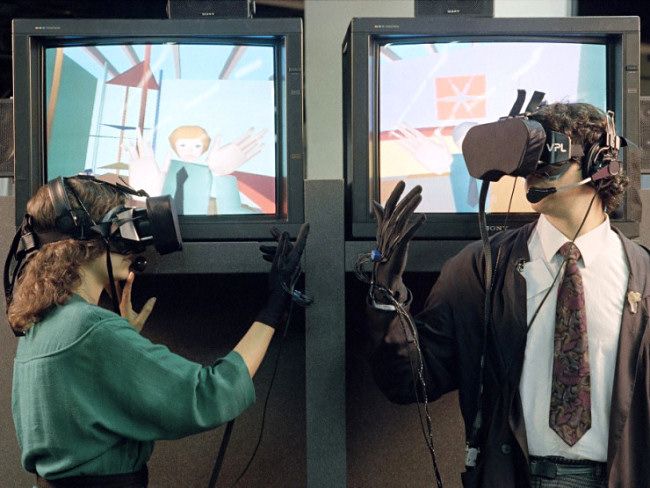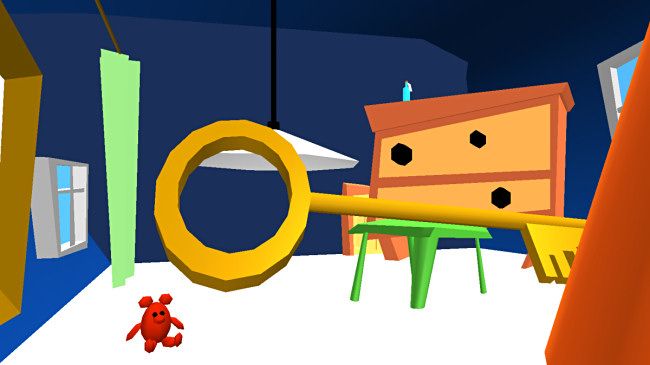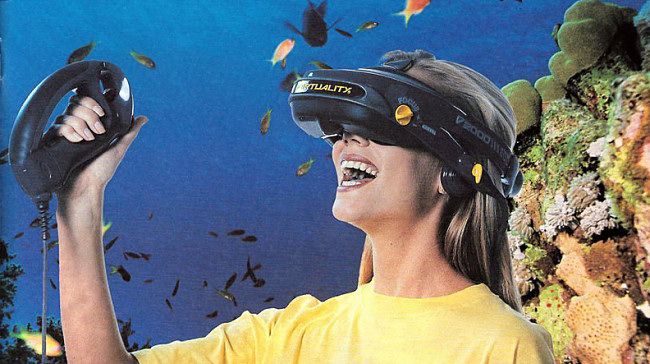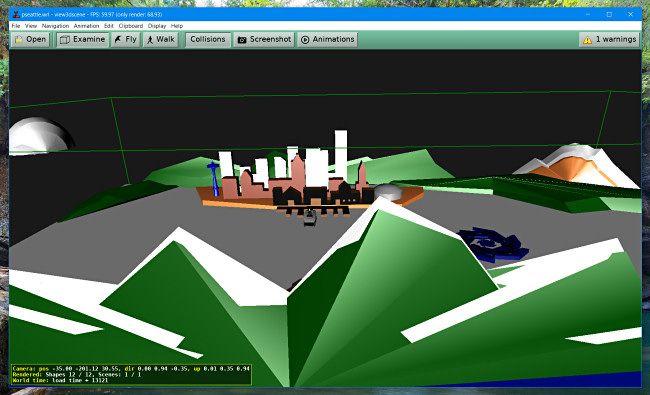
Nostalgia for the '90S Internet: Exploring VRML, the Precursor to Modern Metaverses

Nostalgia for the ‘90S Internet: Exploring VRML, the Precursor to Modern Metaverses
Quick Links
- When 3D Was the Future
- Enter VRML
- Applications of VRML
- What Happened to VRML?
- 3D Archeology: How to View VRML Files Today
In the early 1990s, futurists and corporations combined forces to create VRML , a Virtual Reality Modeling Language that promised to bring 3D graphics and virtual worlds to the web, heralding the dawn of the metaverse . Here’s what it was—and why it didn’t work out.
When 3D Was the Future
At a time when real-time 3D computer graphics were out of reach for the average person, 3D interfaces seemed like the next step forward in the evolution of computers—and maybe even humanity itself . The primary driver of the 3D buzz at the time was virtual reality (VR), which promised bodily immersion into simulated 3D worlds.

NASA
Tucked among flowery, philosophical, and quasi-mystical language about what it meant to be a human in cyberspace in the early 1990s, engineers and journalists postulated that VR would offer new ways to visualize complex data or make a more intuitive interface for interacting with computers. After all, people thought , what could be more natural than using our own bodies and senses as a peripheral to interface computer-generated worlds?
Related: What Is the Metaverse? Is It Just Virtual Reality, or Something More?
In 1992, Neil Stephenson coined the term “metaverse” in his sci-fi novel Snow Crash. It crystallized ideas about the alternate realities in worldwide computer networks that originated from various sources, including William Gibson’s Neuromancer (1984), another influential cyberpunk novel. Without much delay or hesitation, computer engineers who read these books set out to turn these dystopian cyberpunk visions into reality.
Enter VRML
In this atmosphere of VR buzz—in late 1993—software engineers Mark Pesce and Anthony Parisi created the rudiments of a 3D web browser called Labyrinth . In May of 1994, Pesce, Parisi, and Peter Kennard gave a presentation about Labyrinth at the First World Wide Web Conference in Geneva. Not long after, another engineer named Dave Raggett presented a paper that proposed “Extending WWW to support Platform Independent Virtual Reality.”
In that paper, Raggett coined the term “VRML” (for Virtual Reality Modeling Language). He positioned this new 3D browsing technology as the VR equivalent of HTML, which was the primary markup language used to create pages on the World Wide Web at the time. As these concepts coalesced, Pesce and Parisi created the first VRML browser in November of that year.
One of the key strengths of HTML is that it uses hypertext , which allows authors of HTML pages to link to any HTML document on the internet, even those hosted on other servers. Similarly, VRML aimed to allow dynamic linking to (and drawing elements from) virtual 3D worlds across the internet, ideally creating what people now call a metaverse, where people could chat, do business, educate, own property, and more.
(Although the term “metaverse” wasn’t commonly in use at the time to describe this concept, a 1995 article from New Scientist titled “How to Build a Metaverse” made the connection with VRML.)

After picking up support from other developers, the VRML standard debuted in November 1994. At first, VRML only supported 3D static objects, but over time the standard grew to encompass avatars, animations, pulling in multimedia, and more. Early on, VRML drew support from major corporations such as Microsoft, Netscape, Silicon Graphics, and dozens of others. For a short time, its future seemed pretty solid.
VRML files (which usually use the .WRL file extension), store three-dimensional geometric shapes using a text-based language that describes the geometrical properties of the objects. Much like a 2D vector graphics file that contains instructions on how to draw an image, VRML files include instructions needed to render a 3D scene, which makes the format relatively compact, data-wise.
Applications of VRML
So the question remains: Did VRML ever see widespread use? Not really, but relative to the size of the internet at the time, VRML’s reach was wider than you might expect. Several university departments , especially those that studied new media, experimented with VRML and posted their creations online. 3D hardware vendor Silicon Graphics embraced VRML and released 3D animations featuring a character named “Floops .” Wired Magazine initially hosted the VRML Architecture Group and the VRML mailing list .

In 1995, a German company called Black Sun Interactive (later changed to “Blaxxun Interactive”) developed multi-user server software that utilized VRML for graphics and allowed more complex interactions to take place than simply viewing 3D objects. Blaxxun’s software laid the foundation for what was one of the first 3D “metaverses” on the Internet, CyberTown , launched in April 1995. VRML also powered experiments such as a 3D site created by the Atlanta Braves and a prototype virtual clothing store from The Gap , among others. OZ Virtual and several other firms did similar work in creating 3D chat worlds with VRML.

Sony
Sony also ran a popular VRML-powered world in Japan called SAPARi , which ran through a client distributed on its VAIO computers between 1997 and 2001. The story doesn’t end there, but VRML’s fragmented past is currently scattered between the couch cushions of the internet, waiting for someone to pick up the pieces and reassemble the entire puzzle of this lost chapter of online history.
What Happened to VRML?
Spoiler alert: VRML didn’t take off like its creators hoped. While VRML 2.0 became an international standard with the ISO in 1996, the final version of VRML, known as “VRML97 ,” was standardized in 1997. Around that time, interest in VRML began to wane as it became evident that 3D online worlds weren’t as practical or useful as futurists had promised.
In 1996, CNET wrote about VRML’s failure to meet expectations, saying, “Bandwidth constraints, hardware limitations, and, worst of all, lack of compelling applications may make the 3D technology more virtual than real for the time being.”

Virtuality
CNET basically nailed it. Computers were too slow to run complex VRML worlds at the time, and dial-up bandwidth was limited, making loading times painful. Major browsers never integrated VRML support, and users had to rely on third-party plugins or specialized chat clients to utilize it. Not to mention that basically no one ever viewed VRML files with actual VR gear—VR headsets were dramatically expensive and low-resolution at the time.
In addition, creating VRML files using modeling software required a relatively high level of skill, posing a significant barrier to entry for mass adoption of VRML versus people creating text-based web pages. Due to this limitation, many VRML files hosted on the web itself turned out to be simple, static 3D objects that could be rotated and scaled rather than interactive experiences.
Related: There Is No Metaverse (Yet)
CNET also also nailed it when it came to the main reason for VRML’s failure: lack of compelling applications. To this day, there still isn’t a killer app for VR or even 3D computer interfaces beyond video gaming. That’s one of the reasons the metaverse isn’t here yet , and may never be.
In some ways, we surpassed “reality” as the most efficient user interface in the 1990s. Physical embodiment in a VR world is not necessary to write a paper, order a pizza, play music, or share a photo of a cat. There are probably tens of thousands of tasks that can be done more efficiently with a 2D computer interface than with 3D simulated world. There are exceptions of course, but those exceptions still form a niche.
Ultimately VRML was superseded by the X3D standard in 2001 (and some others), but generally, the “platform-independent web 3D” ship had sailed by then, and the buzz had moved on to other technologies and platforms. Hey, remember Second Life ?
3D Archeology: How to View VRML Files Today
Even though VRML has long since become obsolete, you can still get a taste of the future of web-based 3D, 1990s-style. Like a 3D archeologist, you can use a free program called view3Dscene on Windows and Linux to view many vintage VRML files using a modern PC. From our experimentation, the program doesn’t support all elements of the VRML standard, but you can load simple 3D models and view them, and even walk around in them at times.

Also, the X_ITE X3D Browser’s website , which uses a JavaScript library for rendering Web3D and VRML has a gallery of VRML and similar X3D content examples that you can view in any modern web browser, no plugins required.
As for where to find VRML files, we found some artistic ones in this archive , some VRML objects and scenes from CyberTown in a gallery hosted by TheOldNet.com, and more academic VRML files at the Washington University VRML Repository .
Have fun reliving our weird virtual past—which somehow, 27 years later, is still supposed to be the future . No matter how many times futurists claim “this time will be different,” we may always be just a few years away from a 3D metaverse. Only time will tell.
Related: What Is the Metaverse? Is It Just Virtual Reality, or Something More?
Also read:
- [New] First Steps in Digital Content Top 10 Easy-to-Make YouTube Projects
- [New] How to Retrieve Flawless, Copyright-Free Images
- [New] In 2024, Photoshop Techniques for Dynamic, Realistic Text
- [New] Jumpstart Your Snapchat Learn to Create Top Boomers for 2024
- [Updated] Explore Google Chrome's Advanced Multiscreen Capabilities
- 2024 Approved Streamline Your Video Workflow YouTube-to-MPEG Essentials
- From Novice to Expert A Comprehensive Guide to Mac's Preview Software for 2024
- From Standard to Spectacular The Transformative Power of High Dynamic Range for 2024
- In 2024, Explore Movies for Free Simple VIDEO Player Software
- Titre: Sauvegarde Et Configuration Des Postes De Bureau Microsoft Windows Pour Un Travail Efficient
- Troubleshooting and Repair for 'Device Not Found' (Code 24) in Windows Operating Systems
- Title: Nostalgia for the '90S Internet: Exploring VRML, the Precursor to Modern Metaverses
- Author: Frank
- Created at : 2025-02-17 20:47:45
- Updated at : 2025-02-19 18:53:44
- Link: https://some-techniques.techidaily.com/nostalgia-for-the-90s-internet-exploring-vrml-the-precursor-to-modern-metaverses/
- License: This work is licensed under CC BY-NC-SA 4.0.